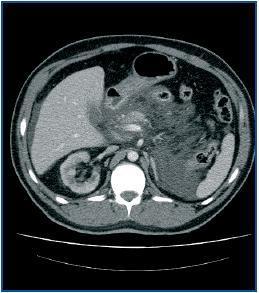Dear Editor,
We are describing the case of a peritoneal dialysis patient who suffered two outbreaks of acute pancreatitis in four months.
27 year old male who was attended at the Dialysis Unit complaining of epigastrium pain lasting 12 hours and vomiting. Patient history: chronic renal failure stage 5 secondary to diabetic nephropathy. Acute peritonitis due to Staphylococcus epidermidis in September, with relapse in October, treated with vancomycin with culture negativization and normalisation of cell counts.
Physical examination revealed marked epigastrium pain. Cell count: 50 leukocytes (65% PMN), amylase 423IU. Other analytical data: leucocytosis 25,700 (92% neutrophils); urea 106mg/dl; creatinine 9.4mg/dl; CRP 24g/l; amylase 172IU/l. Cultures of peritoneal liquid negative. Given the presence of amylases > 100IU/l in the peritoneal liquid and the clinical suspicion of pancreatitis, an abdominal Computed Axial Tomography (CAT) scan was performed: rarefaction of peripancreatic fat and a large amount of free fluid, mainly peripancreatic and perihepatic (figure 1.) Initially, the patient improved. He remained on peritoneal dialysis and metabolic or infectious causes of the pancreatitis were excluded. Four days following admission, the patient presented with fever and peritoneal liquid with more than 100 leukocytes (80% PMS/amylases < 100IU.) Given the history of previous peritonitis due to Staphylococcus epidermidis with subsequent relapse, it was decided to remove the peritoneal catheter and change to haemodialysis. Subsequent evolution was favourable, the fever disappeared and the patient showed clinical improvement.
Two months following the removal of the catheter, and due to preference for this technique, peritoneal dialysis was restarted. Two days later, the patient was seen again with a clinical picture similar to acute pancreatitis, confirmed by cell count of leukocytes of 153 (26% PMN), amylase 418.
Abdominal CAT showed moderate acute pancreatitis. On admission, treatment with antibiotics, digestive rest and fluid therapy was started.
Peritoneal dialysis was ceased and patient was transferred to haemodialysis. The patient improved CT peritoneography was performed, and flow of contrast to the retroperitoneum was not observed. Upon release from hospital, peritoneal dialysis was definitively suspended due to its temporal link to the episodes of pancreatitis. The patient has currently been undergoing haemodialysis for 14 months without presenting any new episodes of pancreatitis.
Acute pancreatitis is a common complication of patients undergoing peritoneal dialysis. The following have been considered as causal factors: metabolic abnormalities (absorption of glucose and dialysis liquid buffers ), infectious stimulus (repeated outbreaks of peritonitis) or irritation of the pancreas via the epiploic foramen, due to hypertonicity or acidic pH.
Our patient did not present metabolic or infectious factors and perhaps there was an anatomic abnormality of the pancreas which, along with the infectious stimulus of the peritonitis, led to the patient suffering repeated pancreatitis.
Figure 1.








